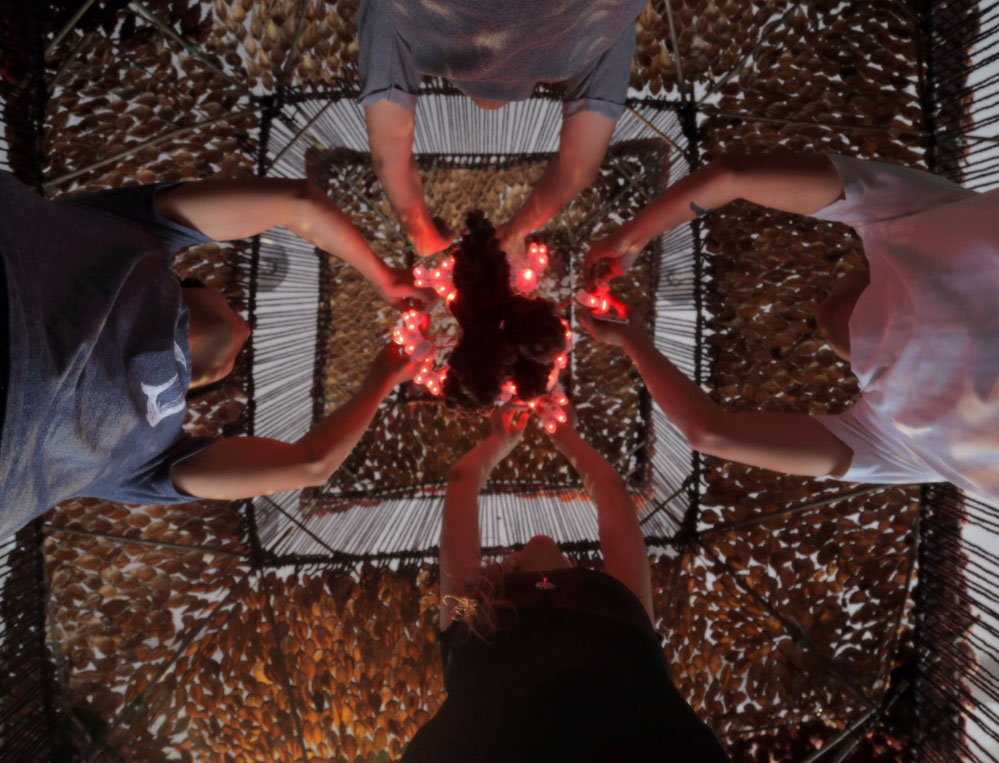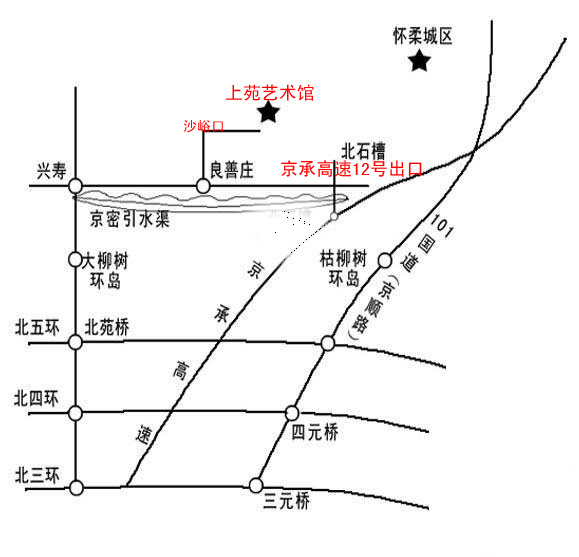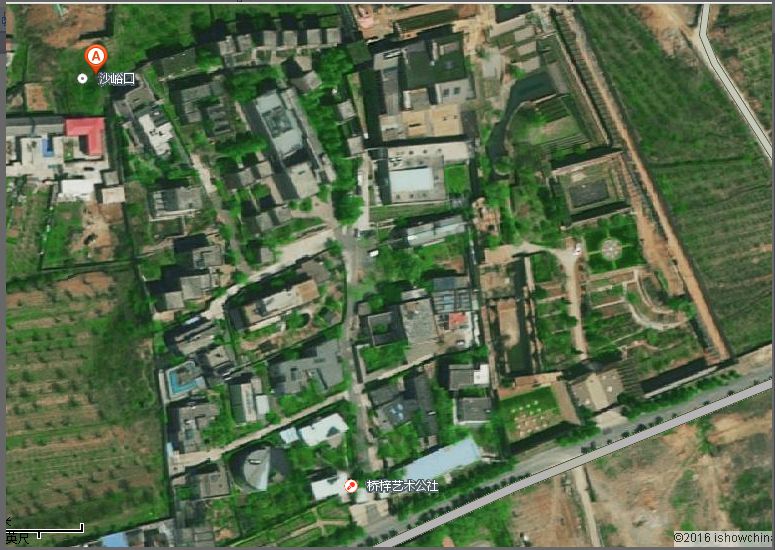|
【现场】 Luz Peuscovich(阿根廷) / Eliza Wapner(美国) 双个展在上苑
[2017-6-26 11:32:27]
展览城市:北京
City: Beijing
参展艺术家/ Artist: Luz Peuscovich(阿根廷) / Eliza Wapner(美国)
开幕时间:2017年6月25日下午3:30
Opening: june 25th 2017 3:30 pm
展览时间:2017年6月25日 ~ 2017年6月30日
Show time: june 25th 2017 - june 30th, 2017
地点:北京怀柔区桥梓镇沙峪口村 上苑艺术馆二号展厅
Venue: Shangyuan Art Museum, Qiaozi County, Huairou District, Beijing
主办单位:北京上苑艺术馆
Organizer: Shangyuan Art Museum
Luz Peuscovich作品

《佛塔》是专门在上苑艺术馆为场景制作的装置。
它的三层结构代表了人生的三个层次:精神在最上层,政治在中间,社会在基础。其内部是一个象征着因自然的召唤而觉醒的符号。



作品制作过程中




作品最后安装中

作品完工后作者露丝·佩斯科维奇(Luz Peuscovich)与作品合影

作品《门》或《虫洞》
这是一个对时间的形态学研究。它的形式代表着女性力量,这种力量掌控着感觉的开放。






上苑艺术馆2017年的驻馆艺术家的作品很多都不一定是在展厅里展示与制作,如阿根廷的驻留艺术家Luz Peuscovich的一些作品就在大自然中进行(艺术馆后面的燕山脚下)。
露丝·佩斯科维奇(Luz Peuscovich)
视觉艺术家//策展人和文化管理人//占星家//建筑者和收藏家//阿根廷人
自述:
我的工作是持续性的探索对空间中的感官的认识、在特定环境下的身体、我们记忆中和潜意识中积累的经验、人性本质的集合、我访问过的民族建筑和当地的环境现实。
物质性是最主要的:从环境中搜集到的不同物品,木头或者茅草搭成的结构和纺织品材料(线、羊毛和丝带)。
整个过程开始于旅行,为了探索他们的领域、了解他们生态系统的特点并仔细搜集相关的物料。因此,每个地方的独特信息逐渐形成一个融合体:自己不但会塑造我们遇见的物体,而且还会影响气候、环境和社会状况。这些次元存在于每个地方,并且它们无法避免地出现的同时,也必然要与它们的居民产生联系。这使得我在某种方式上不得不做出承诺。这些作为整体的经验最终进入了这些装置的创作过程:象征符号和形状的设计,可居住的、浸入式的漂浮的空间。
《避难所》、《社群》里的生活和对《持续性》追寻是我作品的主要概念。通过和自然重建联系和重塑它的形式,这种探寻使得我和本土的社群有了更紧密的联系。这使得我能够见证他们与自然世界之间的结合,见识在他们的无奈地将资本主义内化成习惯(如我们自己一样),并且目睹了生活在一个忽视消费与浪费后果的系统中所造成的巨大的复杂性。
随着时间的推移,这些搜集材料的旅行和之后装置的创作过程,越来越清晰地将前景和我的理解交织在一起了。我发现,在面对这些物品,并将来自不同地方但又相似的材料连结在一起,同时,又遇见不同地方相似的人类经验。这一切都使得我对一个交汇点产生了兴趣:感受我们四周的生物多样性,由此视觉化我们和地球的关系与反省我们的生活方式。
Luz Peuscovich
// Visual Artist // Curator and Cultural Manager // Astrologer // Builder and collector // Argentina
My work is a continuous research on the perception of the senses in space, on the body in certain contexts, the experiences kept in our memory and in our subconscious, human-nature integration, native cultures’ architectures and the environmental realities of the places I visit.
The materiality is essential: different objects collected from nature, wooden or reed structures and of textile materials (threads, wools and ribbons).
The process starts traveling in order to explore the territory, to get to know the particular qualities of their ecosystem and to carefully collect the materials. Thus, a combination of particular information of each place comes up: the own shapes of the objects we come across, as well as climate, environmental, and social situations. These dimensions are there in every place and they inevitably emerge while getting in touch with their inhabitants, making me commit to them in some way.
These experiences as a whole, end up in the development of installations: symbols and configurations of shapes; habitable, immersive and floating spaces
The SHELTER, as well as life in a COMMUNITY and the search for SUSTAINABILITY, is the main concept of my work. It has been through that reconnecting-with-nature (and its shapes) approach that the research brought me closer to the native communities in order to witness the bond they have with their natural world and to see in their habits (as in ours) the sad domestication of capitalism, and the huge complexity that implies living in a system which does not take into account the costs of consumption and waste.
As time passes by, these trips of collection and the subsequent installation construction clearly come up as ways of interweaving points of view and amplifying my perception.
Appreciating the objects, I find, linking similar materials coming from different places, and, at the same time, coming across the same human reactions here and there, have opened my interest to an integration point: feeling the bio-diversity that surrounds us to visualize the bond we have with our planet and question our way of inhabiting it.
Pagoda
Is a site specific installation for Shangyuan Art Museum.
Its three levels represent three strata of life: the spiritual at the top, the political at the center, and the social at the base. Inside is a symbol of awaking representing the call of nature.
Portal
This is a morphological study of space. Its form is a symbol of the feminine force, a force which commands the opening of the senses.
伊丽莎·瓦普勒(Eliza Wapner)/美国
作品展示现场







自述:
现在的这一系列作品主要将注意力集中在治愈的过程上:治愈意味着什么,我们如何能进行治愈?我们每个人都有自己独特的方式从一个创伤性的事件中恢复过来。一些人将这段记忆推到自己脑海的深处,很多年都不会提起它的存在。一些人会喋喋不休地谈起它,用这种方式来面对。有的人在浮华世界和芸芸众生中找到慰藉,另一些人则在凝神静思中找到内心平静。虽然治愈的完成会带来力量和满足感,其过程通常是很困难的,而且力量和满足感之间有一种紧张的不安。这部作品使用材料和过程来表现这种紧张。
在我过去很多的作品里面,我都使用了自然的染料,像是茜草根、红花、和紫草根。它们同时也被用在传统中医里,用来创造色彩和形式。通过使用这些草药,这部作品由此将治愈的特性和我自己的病史结合在一起。在装置《血液的记忆》中,我探索了我在儿童时患有的一种血液疾病。茜草根就是一种用来治疗我作为孩童时所患的血液凝块疾病的药物。我用茜草根将一半的装置染成红色,另一半则用我自己的经血。将两者混合在一起,我由此复活了自己的血液史。
对织物的使用对这些作品也很重要。布料带有温暖和安慰的感觉,是我们赖以生存的重要物品。但是,它同样也很容易被撕坏损毁,代表了一种力量和脆弱的结合。在装置《好运》中出现的绳结,每一个都代表不同事物的集合。第一个是编制绳结的反复性活动可以给人带来沉静。第二是,在中国,传统的中国结象征着祝福和好运。最后一点是,它们代表了温暖和混乱之间一种有趣的平衡。
这两部分作品和剩下的二维作品探索了治愈的所有方面,社会和我自身内部的精神和肉体的健康史。
Eliza Wapner
This current body of work focuses heavily on the healing process- what it means to heal and how we do it. We all have different ways of healing from a dramatic event; some push the incident far back into their mind and don’t talk about it for years, some talk about it incessantly to allow themselves to process it out loud, some find solace in distractions or people, yet others find it within contemplation. While healing brings about strength and fulfillment when finished, the process is often hard and there is a tension between these two feelings. This work uses material and process to explore this tension.
In many of the pieces I have used natural dyes (madder root, safflower, and purple gromwell root) that are also used in traditional Chinese medicine to create color and form. By using this medicine, the subsequent piece of work represents its healing properties connecting my own health history with the piece. In the installation “Blood Memory,” I explore a blood disorder that I had as a child. Madder root is a medicine that helps clotting in the blood, the problem that I had as a kid. I dyed the first half of the installation with madder root and the second with my own menstrual blood. By mixing these two together I am recalling my own blood history.
The usage of textile material is also important in these works. Cloth is warm and comforting and needed for survival, however it can easily be torn and destroyed representing a mix between strength and vulnerability. The knots present in the installation “Good Luck,” each represent a multitude of different things; first the process of creating knots allows for contemplation as does all repetitive action, secondly in China, traditional knots are often seen as good luck wishes, and finally they show an interesting balance between warmth and chaos.
These two pieces as well the rest of the two-dimensional works explore all facets of healing and both mental and physical health history within society and myself.
------------------------------------------
北京·上苑艺术馆 “国际创作计划”(艺术驻留) 常年接受申请
上苑驻馆艺术家的国际居留计划生活记实
就上苑“国际创作计划”答《中国新闻周刊》记者问
上苑艺术馆-程小蓓接受《上层》杂志专访
上苑艺术馆-程小蓓·答韩国光州《全南日报》记者问
程小蓓答《美术周刊》记者问
程小蓓就建筑艺术答诗人、建筑批评人问
美国威斯康辛大学-展出程小蓓摄影《活路》作品选登
【现场】《在可说的这一切》毋蓬勃个展 21日在上苑艺术馆
【现场】“无人栖居” 王毅、闫科含双个展
【现场】 记忆:后视镜中的戏剧——上苑艺术馆主题项目展
【现场】“中国的空间”丹麦艺术家安亚个展26日在上苑艺术馆
【上苑艺术馆】鸟巢展出2015驻馆艺术家作品同步认购价目表
【上苑艺术馆】2007-2008驻馆艺术家作品认购价目表
【上苑艺术馆】 2009-2010驻馆艺术家作品价目表
【上苑艺术馆】2011-2012驻馆艺术家作品认购价目表
【上苑艺术馆】2013驻馆艺术家作品认购价目表
【上苑艺术馆】2014驻馆艺术家作品认购价目表
【上苑艺术馆】2016上苑驻馆艺术家作品认购价目表
北京 上苑艺术馆-107平米房屋转让-相关资料及实景图
出租工作室-上苑艺术馆,电话:60635299
-----------
-------------------
北京 上苑艺术馆- 电话: 010-60635299 60635757
上苑艺术馆官网 http://www.syartmuseum.com/
文学艺术国际联盟(简称:国际文盟)网 :Website: http://www.inlac.cc/
上苑英文站点:http://resartis.org/en/residencies/upcoming_deadlines/?id_content=3938
交通指南 :
□北京东直门916路、942路到怀柔,转怀柔-沙峪口(上苑艺术馆)
□京承高速12出口 > 右拐过水渠西行2KM > 良善庄路口北行到底>右拐300m路北

上苑艺术馆地图及卫星图

查看5338次
|
